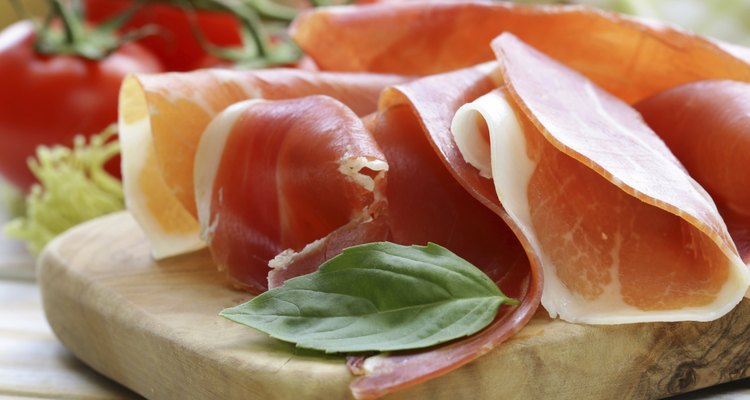
olgakr/iStock/Getty Images
You can make prosciutto at home if you have the space and conditions the technique requires. The average hog leg weighs between 25 and 30 pounds -- after trimming -- and needs at least one year in a room between 34 and 41 degrees Fahrenheit and with a constant humidity of around 75 percent. And that doesn't consider maturation, which requires a room with uniform airflow. If these conditions aren't met, the 25- to 30-pound ham once destined for prosciutto greatness becomes a 25- to 30-pound biohazard. Play it safe -- buy quality prosciutto and spend the time you save enjoying it.
Basic Dry-Curing Chemistry
During dry-curing, moisture, in which bacteria and mold thrive, is drawn out of the protein cells and microbes in meat and replaced with salt -- a process known as plasmolysis. Salt shuts down the processes that allow bacteria and microbes to multiply, opening the door for curing and preservation.
The Process
Transforming ham into prosciutto is a time-intensive process. After initial salting, the ham needs to be pressed to rid it of blood and other fluids, which takes about a day and half per pound; it then undergoes cleaning, resalting and resting before curing can begin. Maturation follows curing, which lasts between one year and three or more years; prosciutto is ready when it loses about 30 percent of its weight in moisture, but there is no limit to maturation time. Both high-quality Parma ham and homemade prosciutto need the same environmental conditions for safe curing.
Environmental Conditions
Prosciutto needs a combination of consistent airflow, cool temperature and moderate humidity in exact proportions to cure without cultivating bacterial growth. Commercially produced prosciutto cures and matures in temperature- and humidity-controlled rooms so each ham experiences the same conditions and develops the same taste, texture, and salt and moisture content. Airflow is controlled manually with windows and electronically with climate-control systems designed for prosciutto production. The curing and maturation rooms have a level of sanitation impossible to re-create at home.
Alternatives
Curing a whole hog leg is too much for almost any home cook, even those with enough space and the proper climate for success. You don't need commercial-grade equipment to cure small batches of meat. Jerky, bacon and corned beef are cured meats you can safely make at home with little expense or effort. Another option is duck prosciutto, or dry-cured duck breast. Think of duck prosciutto as prosciutto with training wheels; it undergoes the same chemical process, but it doesn't require as much aging.
Duck Prosciutto
Pour 1 inch of sea salt or kosher salt in a plastic food-storage container, and press the duck breast in it. Cover the breast with 1 inch of salt and press it firmly; salt should cover the flesh entirely. Cure the duck breast in the refrigerator for three days, turning it over once each day. Rinse the breast and dry it, and then weigh the breast and record the weight. Wrap the breast in cheesecloth and hang it in a room with a temperature between 40 and 65 degrees Fahrenheit and humidity between 60 and 85 percent. Weigh the breast after two or three weeks; it's ready when it weighs 30 percent less than the first recorded weight.
Related Articles
How Long Do You Smoke Ham Per Pound?

How Long Can Smoked Meat Last Without ...
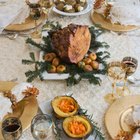
Shank Ham Cooking Directions

How to Make Salt Brine
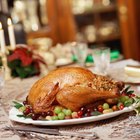
Seasonings for a Turkey Breast

How to Smoke Elk Meat

What Is a Black Forest Ham?
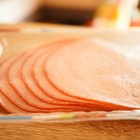
Ham Nutrition Information

How to Defrost a Bone-In Ham
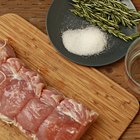
How to Brine Pork Roast
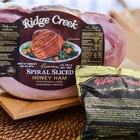
Cooking Instructions for a Ridge Creek ...
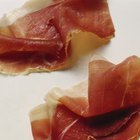
Can I Eat Prosciutto Ham Without ...

The Effect of Salt on the Tenderness of ...

How Do I Roast a Picnic Ham?

How to Carve a Spiral Cut Ham

How to Bake Two Smoked Ham Halves

How to Sugar Cure Bacon

How to Smoke a Venison Hind Quarter

When Does Salami Spoil?

Help Me Cook a Perfect Tender Steak ...
References
- On Food and Cooking: Science and Lore of the Kitchen; Harold McGee
- National Center for Home Food Preservation: Curing and Smoking Meats for Home Food Preservation Literature Review and Critical Preservation Points
- Hunter Angler Gardener Cook: Duck Prosciutto
Resources
Writer Bio
A.J. Andrews' work has appeared in Food and Wine, Fricote and "BBC Good Food." He lives in Europe where he bakes with wild yeast, milks goats for cheese and prepares for the Court of Master Sommeliers level II exam. Andrews received formal training at Le Cordon Bleu.
Photo Credits
olgakr/iStock/Getty Images